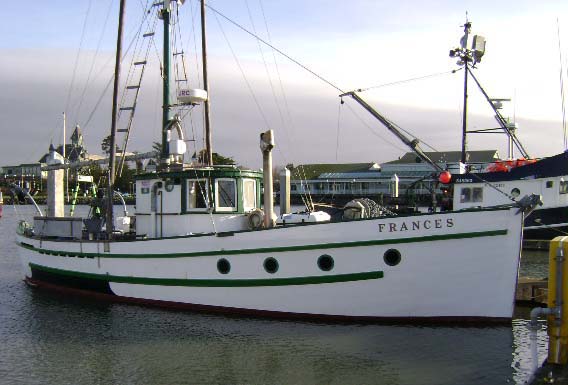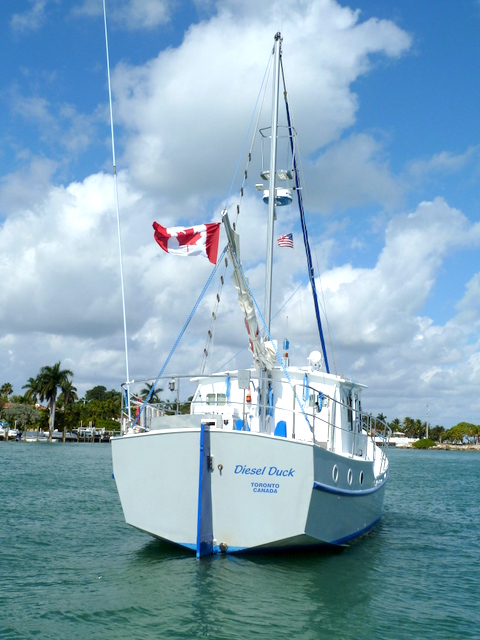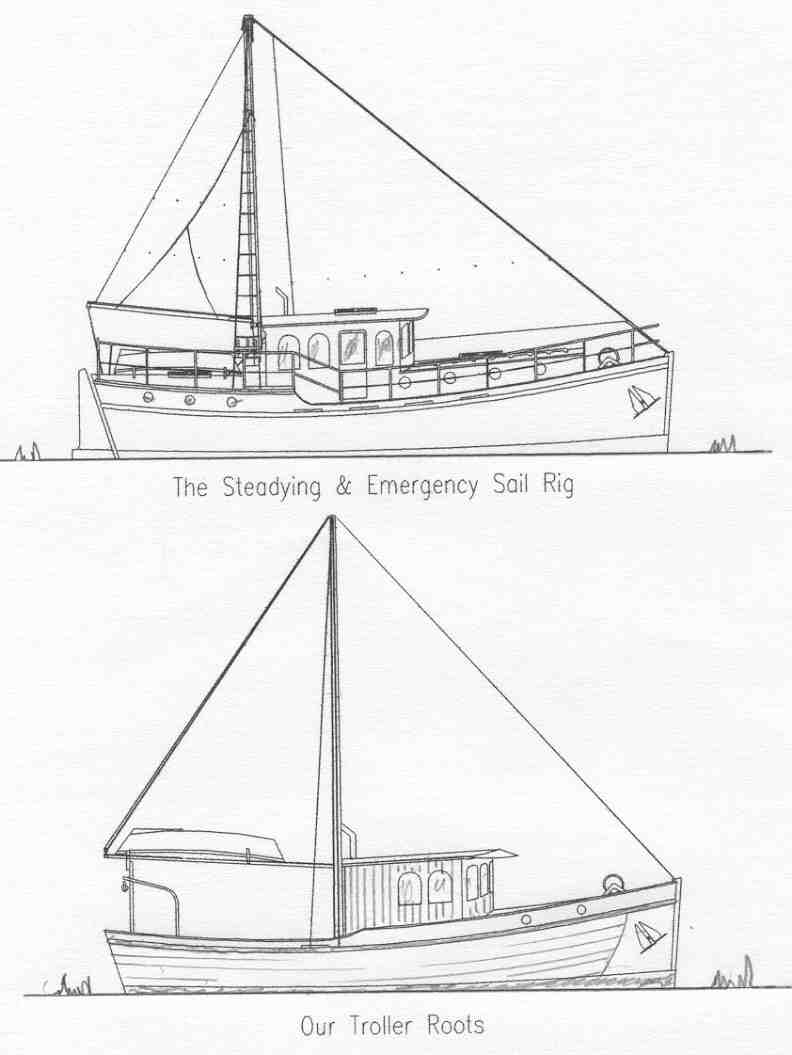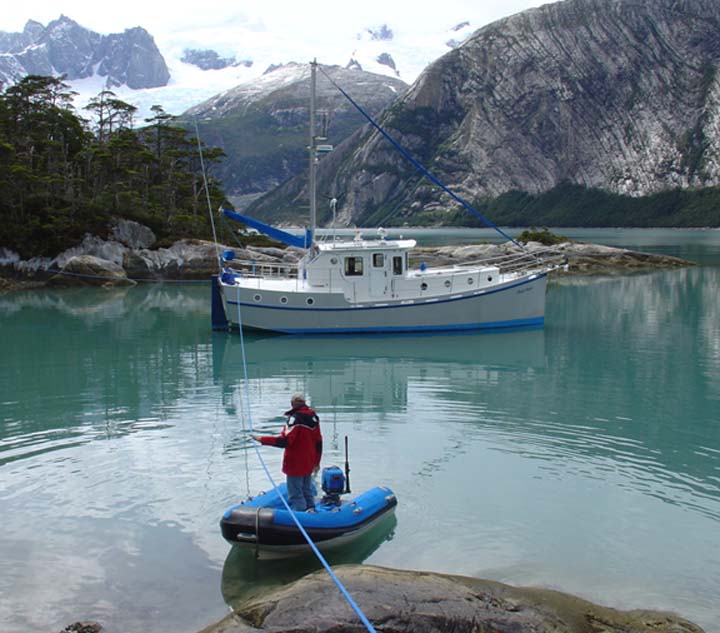2/19/09 Marlene & Benno sent this email from their 41 DUCK (above) via Satellite (what a world!) Note the well dressed German yachtswoman standing in the wheelhouse door!
Hi George and Gail,
It is time to celebrate. Your design, the Diesel Duck 41, just rounded Cape Horn from the west to the east today the 19, Feb. 09 at 17:30 hrs.
Diesel Duck behaved wonderfully even in a shitty sea here at the Horn. She always demonstrated seaworthiness and safety to us. Diesel Ducks are good boats. You can be so proud of the Duck. We are very proud of our Diesel Duck and we will drink a bottle of Martini Spumante as soon as we have the hook down in a safe anchorage tonight, following with a nice dinner.
We have to say “thank you” to Georgs Kolesnikov too, who hooked us up with a good commercial boat yard in Canada who built a strong aluminum duck which withstood a good pounding by working her way toward Cape Horn.
With best wishes from
Benno and Marlene
The 38′ DIESEL DUCK has worked out just great, and is in my possibly biased opinion a wonderful example of a small power cruiser that will take a couple pretty much wherever they want to go. If costs are a major concern, especially longterm moorage costs, than the 38 is a good choice. But, this stretched version will be a nicer boat and won’t cost hardly any more to build because it uses the identical systems: just a bit more steel in it.
This boat, like all my designs, has an interior for long term housing of a couple. The extra 3′ this version has over the 38 is all in the fwd. cabin, and it makes a big difference. I think a cruising boat needs to be strictly set up for the owner’s comfort. The dining table will convert to a guest double if you need to, but I wouldn’t devote precious space to guest quarters.
The entire design, like all my designs, is done on a computer so all dimensioning is accurate to 1 mm making actual lofting unnecessary if you don’t want to.
  |
Here’s the interior I drew for her. Marlane & Benno came up with some real improvements, as the following photos on the next page show.
Here’s a view of her with the back-up sails hoisted. Below that is how she would look if built as a commercial troller. I think a version like this would be great fun for playing with. There’s not room for a great interior, but it would be OKfor day and weekend use, and gives lots of space for sports fishing, crab pots, and so on!
Particulars
LOD: 41′ 2″ …. LWL: 39’2″ …. beam : 12′ 9″ …. Draft: 4′ 6″…. Displ.: 35,775 lbs.
Power: 50 to 80 HP
Projected speed/power requirements, calm and off-weather conditions. Note: I’m saying CALM conditions. Calm means calm. Yes, it will take more power to plow into a breeze or a current.
|
V/L – Knots – HP 1. 2 7.52 14.6 1.25 7.83 19.5 1.30 8.14 26.5 1 .35 8.46 36 |
This photo was shot by somebody on shore as Diesel Duck passed by on her original cruise South!
Here’s a letter from Venezuala. Note the price of diesel down there. I think this is from about 2010, I forget….
Dear Friends,
We don’t know what it is with Venezuela. Cruisers get stuck herein Porlamar, Margarita Island. Some folks have been here for over seven years. We’ve been here now two months. Perhaps it’s the beer, (25 cents) or the cuba libre (cola rum with lime) for less than a dollar. Maybe for some, but really not for Diesel Duck. It’s the people here on the island. The Venezuelans are wonderful. Always cheery and they try their best to make you feel good. It feels here a little bit like Spain or Miami. Supermarkets with low food prices we haven’t seen for a long while. They even provide free bus shuttles with the groceries delivered right to the dinghy dock. Okay, dinghies get stolen here once in a while, if you leave them overnight in the water behind your boat. But that can happen also in Miami or Nassau. Basically, everywhere in the Caribbean. Margarita is a magnet. We have over a hundred international boats anchored here. Mainly Europeans, Swedish, Danish, Dutch, Polish, lots of Germans and French, Spaniards, Aussies, British, Canadians and some Americans (yanks). We have not experienced any anti American feelings here. On the contrary, there is an open arm policy here in Margarita, demonstrated while we toured the island and on many excursions on our own.
Benno and I celebrated our 40th wedding anniversary with a dinner out at the upper class restaurant here in the marina. I had lomito (filet mignon) with peaches and baked potato, Benno had lomito with mushrooms and french fries. We drank red wine and had cake for dessert. The bill, including tip came to US $35 for both of us. When we first arrived, Diesel Duck took on diesel fuel. It happened that the fuel boat, which comes alongside, delivers beer too and the boat looks and sounds like the “African Queen” from the Humphrey Bogart movie. We took on 1,800 liter diesel, six 24 pack cases of Polar beer (Klaus, Polar beer, not Schneider beer) and 20 liter dinghy motor gas for $200 US. The diesel boat charges 200 bolivar/ltr for diesel and gas. However, on the mainland the diesel is only 48 bolivar/ltr according to reports from charter boat skippers. This is the price in Cumana. The official exchange rate is US $1 = 2150 bolivar. So a liter diesel cost 1.86 cents. A US gallon cost 6.93 cents. As a side note, on the black market you can get up to 2,500 bolivar for a dollar. A German yacht in the anchorage took on 20,000 liter diesel from the “AfricanQueen” and this is all pumped in by hand. It was a two day affair. The captain of the diesel delivery boat has 21 children (several wives) and some of his sons are on board to help pump the fuel. During the normal run he is carrying 1,200 liter in barrels in one shot. But when a big yacht is coming in, he will increase his capacity to 4,000 liter in barrels. The pump he uses is the type of pump you use on 50 gal oil drums. The one with the suction pipe and the crank. You can see these at Princess Auto or Graingers stores.
The last time we wrote, DD was still in St. Lucia, where we stayed a week. Four days in the bay and then three days in the lagoon in front of the marina. Benno had spotted the wifi antenna through his binoculars and after a little anchor maneuver, we got a super reception. Together with a few boats we sailed to Bequia, then on to the Tobago Cays, the snorkel paradise. God, this place was busy. Everybody is down there and we had a hard time finding an anchor spot. Next stops were Mayreau and Carriacou before moving on to Grenada. Grenada is a special island. You all know it was hard hit by hurricane Ivan, but the rebuilding process is going well and stores are fully stocked again We spent a few days in Clarkes Court Bay Marina (www.clarkescourtbaymarina.com) to personally inspect the round bar building in the marina which was built to Canadian standards by our friend Frank from Ajax, Ont and it was one of the few buildings in Grenada which did not loose its roof by Ivan. (Diane you can be proud of your Frank. He did a fine job on that beautiful round sports bar). After two weeks in Grenada, DD sailed overnight to the unspoiled isles of Los Testigos off the Venezuelan coast. The Coast Guard post granted us a three day limited stay there and we anchored in front of the fishing village on Testigo Grande. A bad weather front blew through and during a 50 knot gust, our new wind generator made noises like a turbo prop plane before crashing and bit the dust. We have to send the wind generator in to the USA for repair.
From Los Testigos we moved on to Porlamar, Margarita Island. In the middle of September we decided to cruise to Puerto la Cruzon the mainland. Basically South America. To get there, we stopped in Cubagua, which was the first European settlement in America. Columbus saw Indians with pearls and discovered the source of the pearls to be the pearl beds off Cubagua. At the height of the pearling industry, Cubagua pearls provided Spain with a wealth almost equal to that of the gold transported from the Incas. We anchored very close to the fishing village to be safe for the night, because from here to Puerto La Cruz is bandito country or piratas, how they call them and you have to be on guard. The furthest house to the right in the village is occupied by a larger family who just returned from fishing. We waved them over and handed lollipops to the children in the boat and a jug of cooking oil to the only female on board. The fishermen watch over the anchored cruising boats and make sure they will not be pestered by pirates. The fishermen are honest people. In return for our gifts they gave us a nice grouper, still flapping around in the galley sink. You cannot get a fish any fresher into the frying pan. Our supper was secured for the night. Next morning DD headed for Mochima at a National Park. A sunken valley like a fiord is nestled between the mountains and on the bottom is the town of Mochima. We got there just after lunch and anchored. The park is patrolled by armed park rangers, so it is safe there.
Before I keep on writing about our next ordeal, I should mention that on DD we use for navigation paper charts and electronic charts from C-Map. On C-Map you leave an electronic trail with your GPS when moving. You can always retrace your track in case you get in trouble, even in pitch dark nights. (We have done this on a few occasions!)
Alright. After the anchor was down in Mochima we changed our mind and decided to move on. In our opinion, the water was too muddy and had too much floating garbage. We raised the anchor and moved out of the fiord and six miles further west to the Islas Caracasde Oeste. There we found a nice, deserted anchorage, clear water, white beach, well protected from the wind. This is the place you always seek, or so you think. Wrong. Big mistake!
Benno jumped in, snorkeled and scraped some barnacles off DD bottom and cleaned the waterline. A refreshing task in 40 deg. C. weather. We had a nice barbecue for dinner and afterwards sat down on the foredeck with drinks to watch the sundown. A perfect evening in a perfect setting. It was getting dark as Benno and I saw, at the same time, a penero, a local type boat, which nosed itself around a headland into our bay. Benno thought he’d seen this penero hours ago while snorkeling. Then it had moved at a distance with one guy on board. But this time there were four guys on board. In the way how they approached and how they looked, we got the impression that this was not the friendly neighbourhood visit. Here came trouble. These guys were not like the friendly fishermen from Cubagua. We went inside, closed all hatches and ports but left the upper part of the dutch door open. Benno fetched the flare gun, the bear attack deterrent and the cattle prod. We quietly discussed our plan what to do, while the penero was coming toward us. We were hoping to get a chance to raise the anchor and get the heck out of there. Benno said to them: “Buenos dias, senors.” The guy on the two 40 Hp outboards was standing and saying something in Spanish, which we guessed was: “Are you Americans?” The other three guys were sitting and they kept their hands below the gunwale, holding on to something hidden underneath some old canvas. My captain responded: “No, Canadiense,” smiling. The other guy went on in Spanish. No friendly looks. Tension was there for sure. Benno went on to say: “Si, and buenos noche” and “gracias.” I could see my husband was exhausting his Spanish knowledge rapidly. Smiling to them through the upper dutch door, to ease the tension, while holding the flare gun behind the lower door in one hand, hidden to them. Thanks God, the leader on the outboards throttled up and moved some 600 yards, where he stopped and they had a discussion. This was our chance. By now it was totally dark outside. As instructed, I switched on the anchor winch and started the diesel, putting my hand over the audio alarm, of the engine panel, to dampen the noise. DD engine is very quiet and the exhaust is muffled. You can stand next to the boat and don’t hear her engine going. At the same time Benno went forward to the bow and very quietly removed the chain snubber and then brought up the chain and anchor. In the meantime I had started the C-Map plotter and changed the screen to night vision. We kept the boat dark, no lights inside or out. Once the anchor was up, we sneaked out the bay into the open water, retracing our old track on C-Map. Before the guys on the penero noticed our departure, we had covered at least one and a half miles and were going now almost full throttle. They started to follow us, but then decided otherwise. A couple of hours later our hook dropped again at Mochima fiord, close to other cruising boats in front of the town. Relieved, we celebrated our escape, when all was still with cuba libre on ice. We should have known. You don’t anchor by yourself without any buddy boats in this part of Venezuela. This is the wild west here. We still think these guys were harbouring a second agenda and wanted to take us out. We were lucky and will be a lot more careful in the future.
The next morning DD sailed on to Puerto la Cruz and during this trip a school of dolphins were playing in our bow wave for over an hour. What a joy. Puerto la Cruz is the center of yachting in Venezuela. No anchoring here. Not safe. You have to go into a marina. DD tied up at the PMO marina ($15/day incl. water and electricity) and wifi close by.
Hoping this letter finds everyone in good health, we are looking forward to hearing from all of you once in a while. We’ll keep you informed of our travels.
With love,
Marlene and Benno aboard Diesel Duck
 |
 |
 |
 |
Continue on to see the beautiful interior Benno & Marlane built in their 41.
The 38′ DIESEL DUCK has worked out just great, and is a wonderful example (look, I’m the designer so please excuse me but ILIKE the boat) of a small power cruiser that will take a couple pretty much wherever they want to go. If costs are a major concern, especially long term moorage costs, than the 38 is a good choice. But, this stretched version will be a nicer boat and won’t cost hardly any more to build because it uses the identical systems:just a bit more steel in it.
This boat, like all my designs, has an interior for long term housing of a couple. The extra 3′ this version has over the 38 is all in the fwd. cabin, and it makes a big difference. I think a cruising boat needs to be strictly set up for the owner’s comfort. The dining table will convert to a guest double if you need to, but I wouldn’t devote precious space to guest quarters.
The entire design, like all my designs, is done on a computer so all dimensioning is accurate to 1 mm making actual lofting unnecessary if you don’t want to. Plans are available on paper and mailed to you.
Building Plans, furnished on paper are $1975.
Please add $10 for air postage in N. America, $25 for air postage to Europe, and $30 for air postage to the South Pacific countries
Particulars
LOD: 41′ 2″
LWL: 39′ 2″
beam : 12′ 9″
Draft: 4′ 6″
Displ.: 35,775 lbs.
Power: 50 to 80 HP
Projected speed/power requirements, calm and off-weather conditions. Note: I’m saying CALM conditions. Please don’t be one of those people who don’t understand that and write asking me the basis of the calculations. Calm means calm. The boat does carry 80 HP. For when it ain’t calm…. Here’s what the computer says the power requirements are (calm and off-wind conditions).
V/L – Knots – HP
1.1 6.89 9.2 1. 2 7.52 14.6 1.25 7.83 19.5 1.30 8.14 26.5 1.35 8.46 36





